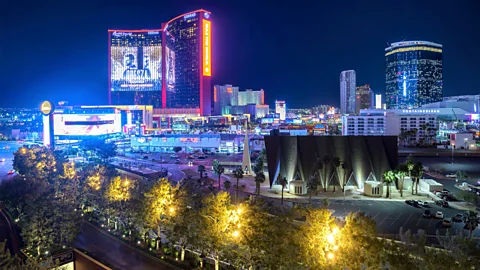'Sin City could be called Solar City': How Las Vegas is going green
 Getty Images
Getty ImagesFrom conserving water to scaling up solar, Sin City is investing millions in sustainability measures.
Las Vegas is notorious for bright lights, excess and hedonism. But America's playground – or to use its better-known nickname, Sin City – is going green. From water conservation and waste management to solar power, the city has invested millions in pushing sustainability initiatives.
"The effort began in earnest in 2005," says Marco Velotta, who serves as the city's sustainability officer, "and accelerated with the Recovery Act in 2009". The federal act set targets for renewable energy, water conservation, recycling and green buildings.
"With the Recovery Act and City Council direction, the city was able to make an initial investment of $75m (£58m) in sustainability projects," Velotta says.
Despite a dramatic population increase, water consumption has dropped "significantly", he says. By 2030, 50% of all Nevada's electricity is expected to be generated from renewable resources.
The Las Vegas strip in particular has doubled down on efforts to switch to renewable energy. Most resorts developed sustainability initiatives thanks to a 10-year-long 50% property tax abatement programme previously offered by the city (the scheme has now closed). The resorts are also required to comply with the state's standard of deriving energy from 40% renewable sources. "Most have exceeded 40%," says Velotta. "Las Vegas has come a long way in a short amount of time.
"Initially tourists were also surprised by the city's sustainability efforts. However, since Las Vegas has emerged as a leader in this area, sustainability has become a part of the city's overall story."
 Getty Images
Getty ImagesEven though the progress made by Las Vegas's notoriously excess-laden strip may seem impressive (Las Vegas's commercial sector accounts for one third of Nevada's total energy usage), the strip started from a "relatively low baseline", points out Steffen Lehmann, professor of architecture and urbanism at the University of Las Vegas, Nevada. He adds, though, "notably, the strip is making strides, with a concerted effort to enhance the energy efficiency of resort hotels through solar power integration and increased natural daylight".
Solar city
Las Vegas is second in the US for solar capacity per capita – Honolulu is number one. "Sin City could be called Solar City," says Lehmann. And resorts have been capitalising on the 320 days of sunshine the city receives every year.
The hospitality company MGM Resorts International developed its own 100-megawatt solar array, which provides power to 11 of its properties in Las Vegas – the equivalent of powering 27,000 homes. But even this, plus additional energy bought from a solar supplier, isn't enough to power the 11 properties round the clock. The company has a goal to source all its energy from renewables by 2030.
Las Vegas lies in the water-scarce Mojave Desert, which makes water conservation "paramount" in the hotel chain's efforts to make its operations sustainable, says Michael Gulich, vice president of environmental sustainability at MGM Resorts International. He says the MGM hotel properties on the strip have conserved 16 billion gallons of water since 2007, thanks to "aggressive" water policies. These include replacing grass with desert-friendly landscaping, installing water-efficient taps across all properties, and reusing water at aquariums and in the Bellagio Fountain.
"The overall water use per capita [in Vegas] is still far too high," warns Lehmann. "There was simply such excessive waste before [resorts] started to conserve water in 2007."
 Alamy
AlamyIn 2023, Resorts World Hotel announced it had achieved a milestone – being powered entirely by renewable energy sources, two years after it opened. NV Energy supplies the 3,500-room resort with renewable energy, derived from solar, geothermal and wind plants in Nevada.
The hotel's head of sustainability, Brandon Morrison, says that during construction, 13,000 tonnes of steel was salvaged from the framework of a development that was abandoned during the 2008 economic downtown. The firm invested more than $1bn (£772m) in energy efficiency upgrades, he adds.
"Although Resorts World presents impressive sustainability figures, it stands as an anomaly among the Strip's hotels, many of which perform poorly in terms of environmental responsibility," says Lehmann.
The significant solar power and water-saving initiatives that many resorts in Las Vegas are using are "necessary steps for a rapidly growing desert city", he adds. "The Strip has emerged as a notable case study in the effective use of renewable solar energy and water conservation."
A work in progress
There are still great challenges ahead for this vastly energy-intensive city.
"The primary sources of greenhouse gas emissions in the city are twofold: transportation, particularly from cars and trucks, and the excessive use of air conditioning," says Lehmann. "As a young desert city – only 119 years old – Las Vegas must work diligently to be resourceful and sustainable."
More resorts are developing their own solar power systems, which include battery backup systems so solar power can be stored and used when the Sun goes down. More than 97% of water used in Las Vegas is recycled, adds Lehmann, vital considering the rapidly depleting Colorado River on which the city depends for freshwater.
"It is gratifying for us to note that at one time Las Vegas was viewed as a city of waste and excess," says Velotta. "However, through our extensive sustainability efforts, we are now recognised as a world leader in sustainability and environmental commitment."
--
For essential climate news and hopeful developments to your inbox, sign up to the Future Earth newsletter, while The Essential List delivers a handpicked selection of features and insights twice a week.
